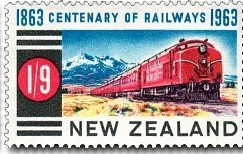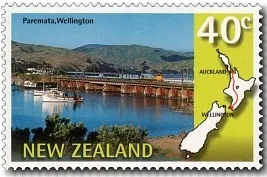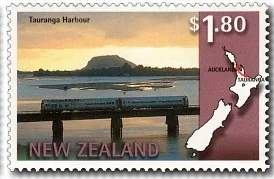
Another of my interests besides Stamps is Trains. I like any trains anywhere but since this blog is about New Zealand stamps I suppose, I should display New Zealand trains.
Over the years New Zealand has issued four sets of train stamps plus quite a few others depicting trains or train related subjects. Let's have a look at them.
In 1940 New Zealand celebrated it's centenary with a set of pictorial stamps featuring different aspects of the country's history. One value of this issue depicted transport showing a bullock team, a ship, an aeroplane and of course a train. The train shown is a KA class pulling a passenger train through the New Zealand countryside. I think this was the very first time a train has appeared on a New Zealand stamp.
The Progress of Transport
1940 Centennial 4d
1963 Railway Century.
A two value issue to mark 100 years of railways in New Zealand.
This set can be viewed in more detail with some interesting items on their own page
1963 - 1973 Railway Locomotives.
The 10 Class DF (2-Co+Co-2) introduced in 1954 were New Zealand's first mainline diesel-electric locomotive. Built by English Electric of Great Britain the DFs and their half-size sisters the DGs were superseded by the more robust USA build DA Class. Although depicted here hauling a Main Trunk express under the watchful Mount Ruapehu in the background, they spent most of their working life on less important routes such as the Bay of Plenty line.
This stamp featured the early steam locomotive 'Pilgrim' and a 69 ton 750 hp "DG" class A1A-A1A diesel-electric locomotive. Pilgrim hauled the first train on New Zealand's first steam-operated railway between Christchurch and Ferrymead. The DG class was the small single cab sister to the more powerful DF Class depicted in the higher value of this issue.
A First Day Cover showing 'Pilgrim' from 1863 and a class DA locomotive of 1963.
Another First Day Cover showing an actual photograph of 'Pilgrim'.
1973 Steam Locomotives.
1973 saw the issue of another NZ train issue. This time the theme was New Zealand designed steam locomotives. This set can be viewed in more detail with some interesting items on their own page
"W" Class Tank Locomotive - 3c
The "W" Class tank locomotive was the first engine built by the New Zealand Railways Workshops in 1889. It was very useful for branch line and suburban passenger work. The "W" Class was followed by other tank locomotives of similar but more modern design including the famous "Wab" Class.
"X" Class Locomotive - 4c
The "X" Class locomotives first built in 1908 were among the first four-cylinder compound locomotives in the world. They were specially designed for heavy service over the steep grades of the North Island Main Trunk.
"Ab" Class Locomotive - 5c
The "Ab" Class locomotive was for many years the Railways' maid of all work and between 1915 and 1926, 141 were built. They could be found roaming all over the NZR rail system doing anything from mainline passenger work to branch line freights. No. 608 "Passchendale" the locomotive depicted on the stamp was one of two engines of this class to carry a memorial plaque.
"Ja" Class Locomotive - 10c
The "Ja" was the last steam locomotive to be built by the New Zealand Railways and No. 1274 was the last of 35 of this class built. The "Ja" was an upgraded version of the "J" class designed for mainline passenger and fast freight work.
1973 saw the issue of another NZ train issue. This time the theme was New Zealand designed steam locomotives. The full set of four can be seen on the First Day Cover above. The locomotive featured on this cover is the "Ab" Class Locomotive from the 5c value.
1982 Architecture
Dunedin Railway Station - 30c
The Dunedin Railway Station is a fine example of Flemish Renaissance Revival architecture. The station is constructed of dark basalt from Kokonga in the Strath-Taieri with lighter Oamaru stone facings, giving it the distinctive light and dark pattern common to many of the grander buildings of Dunedin and Christchurch. A not to be missed attraction is the booking hall which features a mosaic floor of almost 750,000 Minton tiles.
At its peak, it was the busiest station in New Zealand with over 100 passenger train arrivals each day. Today with passenger activity dwindling to a couple of tourist operations, the station building has been put to other uses. It is still an important icon for the city.
1985 Bridges
South Rangitikei Rail Bridge - 45c
When New Zealand issued a set of four values depicting bridges, one of the stamps showed a modern rail bridge from the new route of the Main Trunk Line over the Mangaweka Deviation. Because of the danger of flash floods and earthquakes, this bridge is able to move and in the event of an earthquake, the legs of the high slender piers are designed to alternatively lift off their foundations. Of course being 1985, the passenger train on the bridge is the Silver Fern Railcar.
1988 Electrification of the
North Island Main Trunk Railway.
Cover 24th June 1988.
Stampways is an NZ Alternative Postal Operator.
The North Island Main Trunk (NIMT) is the main railway line in the North Island of New Zealand, connecting capital city Wellington with the country's largest city, Auckland. The line is 682 kilometres (424 mi) long, and on its route passed through Paraparaumu, Palmerston North, Taihape, National Park, Taumarunui, Te Kuiti, Hamilton, and Pukekohe.
1997 Scenic Train Rides.
The Overlander - 40c
Wellington - Auckland 1991 - 2012.
In 1991 the Overlander replaced the Silver Fern Railcars with a locomotive pulled express train. Over the years the train sometimes ran a daily service or ran 3 days per week according to demand. At its peak around 2008/09 the service had reached its full capacity with almost all of it 160 seats taken each day but by 2011 numbers had begun to decline again. In 2012 the Overlander was replaced by the Northern Explorer, a new service with upgraded rolling stock.
The Tranz Alpine - 80c
Christchurch - Greymouth 1987 - Present.
The Tranz Alpine, the 'flagship' passenger train of New Zealand, runs from the east to west side of the South Island through the Southern Alps from which it gets its name. The train passes under the main divide via the 8.5km Otira Tunnel. The train is very popular with tourists who often have lunch in Greymouth and return to Christchurch on the afternoon return service. Over the years the train has used a number of different consists and it is still popular today, particularly with tourists.
The Southerner - $1.00
Christchurch - Invercargill 1970 - 2002
The Southerner followed the Main Trunk Line south from Christchurch and was one of the last passenger services to be hauled by steam locomotives. Various consists were used over the years but the Southerner was never as popular as the other two South Island long distance trains. In 2001 the service had declined to 30 - 40 passengers per day, roughly half of what was required to make the train pay, so after attempts were made to save the train, it was discontinued in 2002. Today there are no passenger trains running on this route.
The Tranz Coastal Pacific - $1.20
Christchurch - Picton 1988 - Present.
This train replaced other railcars and expresses which ran this same route. In 1987 it was decided to upgrade this service to target the tourist market by providing similar rolling stock to the successful Tranz Alpine Express. This new train was known as the Coast Pacific and it is an important link between Christchurch and the Cook Strait Rail Ferry. Over the years it ran in a variety of configurations including the Connoisseur car, backpacker's car and the Lynx Express. The train is still running as of June 2016.
The Bay Express - $1.50
Wellington - Napier 1989 -2001.
The Bay Express was preceded by the Endeavour which ran the same route from 1972 -1989. The timetable for the ‘Express’ had an 8am departure from Wellington, reaching Napier at 1.30pm. The return service departed Napier at 2.30pm and arrived in Wellington at 8pm. At first, this service was well received by the public but being able to attract significant tourist traffic, by 2001 app. 45 passengers were using the train. This was considered too unprofitable so it was decided the service should be discontinued.
The Kaimai Express - $1.80
Auckland - Tauranga 1991 - 2001.
In 1991, the Silver Ferns that had operated the daily service between Wellington and Auckland were replaced by the locomotive-hauled Overlander, making them available for the Geyserland Express to Rotorua and the Kaimai Express to Tauranga. The southbound service of the Kaimai Express departed Auckland at 8:20am and reached Tauranga 3 hours 31 minutes later at 11:51am. The northbound service left Tauranga at 1:05pm and reached Auckland at 4:34pm, 3 hours 29 minutes later. The Kaimai Express did not make a profit, and in 2001 it was announced that the service was too uneconomic for Tranz Rail to continue.
1998 Israel '98 World Stamp Exhibition.
New Zealand produced two miniature sheets for this exhibition. One of them included three stamps from the 1997 Scenic Train Rides Issue. I like the train stamps but I'm not very impressed with the scene on the sheet itself. I would have thought a photograph would have worked better. The trains included were The Tranz Alpine - 80c, The Southerner - $1.00 and The Bay Express - $1.50. Two of these trains have now been discontinued.
2001 One Hundred Years of Mail.
Railway Travelling Post Office - 40c
The overnight expresses between Auckland and Wellington pulled a special car fitted out as a mobile sorting post office. As the train proceeds from station to station mail was sorted on the move.
2001 Dunedin Railway Station - Local Definitive.
(New Zealand WinePost.)
2001 New Zealand Wine Post Sunday Post issue.
50c - Dunedin Railway Station - FDC.
2002 Architectural Heritage
Dunedin Railway Station $1.50.
Another view of this iconic railway station. Today this building is headquarters of the Taieri Gorge Railway for their tourist trains to Middlemarch via the Taieri Gorge or their Seasider tourist service to Palmston. These are the only two passenger trains
currently using the station.
2003 Dunedin Excursion Trains - Locomotives Definitives.
(New Zealand WinePost.)
The Taieri Gorge Railway - First Day Cover.
The Taieri Gorge Limited is New Zealand's longest tourist railway and stretches along the former Otago Central Railway from the 4 km peg on the Taieri Branch, 18 km west of Dunedin, to Middlemarch, a distance of some 60 kilometres. Between Dunedin and the start of the line, its trains operate on KiwiRail's Main South Line via a running rights agreement.
2005 Commemoratives.
50th Anniversary of New Zealand Lions - $1.50.
The train viewed is a scale model used by a club
to pull small carriages of people.
2008 Centenary of the North Island Main Trunk Line.
This set of five values was issued in 2008 to mark the centenary of completion of the Main Trunk Line, the main line connecting Auckland with Wellington through the rugged centre of New Zealand's North Island.
1908 Last Spike Ceremony - 50c
The two rail-heads met and on 7 August 1908, the line was ready for the 11-car Parliamentary Special carrying the Prime Minister Sir Joseph Ward and other parliamentarians north to see the American Great White Fleet at Auckland. But some sections stilled needed further finishing and ballast and so it would not be until 6 November, 1908 before Joseph Ward would drive the last spike completing the line.. Today the 'Last Spike' monument can still be found near Pokaka.
 WikiMiniAtlas
WikiMiniAtlas
1958 Taumarunui - $1.00.
Many towns sprang up along the new line, both for support of the construction and for the operations which followed. Taumarunui was always an important town from being the base for locomotives on the Trunk or in later years home for the CTC control of the line. I remember once I actually got to see the operator and watched him controlling trains moving on the line. Today all of this has been moved to Wellington. The stamp above shows KA947 on display at the station in 1958 during the town's 50th anniversary celebrations.
1963 Makatote Viaduct - $1.50.
The Makatote Viaduct, 79m high and 262m long is one of the largest on the Main Trunk Line. In 1963 the DA diesel had taken over much of the traffic over the main line but there was still steam called on from time to time when required. The Makatote Viaduct was the first of the big viaducts which I ever saw. I remember driving alongside Main Trunk when suddenly we came across this viaduct. The road climbs to the bottom of the valley to cross a low bridge. For there the viaduct looks so impressive being crossed by a freight train.
1964 Raurimu Spiral - $2.00.
One of the most important features of the Main Trunk Line is the Raurimu Spiral used to lift trains up on to the volcanic plateau. This was an amazing solution using 2 tunnels a complete circle and a number of other sharp horse-shoe curves. In the stamp above we see a steam engine pulling a freight train up the spiral. By 1954 this scene was dated as before long diesel would take over all traffic on the Main Trunk and steam would be only found in the Preservation Societies.
2003 Overlander, Hapuawhenua Viaduct - $2.50.
During a major rebuild for electrisation the old Hapuawhenua Viaduct, a steel curved viaduct similar to the Makatote above, was bypassed by this new concrete structure. That is the Overlander, the daylight passenger train which replaced the Silver Fern as mentioned above.
2008 Interislander Rail/Car Ferry. (Cook Strait Ferry)
In 2008 NZ Post issued a fun sheet of stamps called The A to Z of New Zealand. The stamp for the letter "I" shows the Interislander. This is a ferry service across Cook Strait between the North Island and the South Island. This service is rum by the railways and carries both rail vehicles and road vehicles. It is an important link between the two main islands.
2012 Beijing International Stamp and Coin Exhibition.
Dunedin Railway Station.
I was a bit surprised to discover the background photo on this miniature sheet when I was working on my Chinese New Year Collection. The event celebrated is a Chinese Stamp Exhibition. The stamps are from the 2012 Chinese New Year. So what is the Dunedin Railway Station doing in the background? NZ Post explains that Dunedin was one of the earliest settlements for Chinese immigrants in New Zealand.
Notice the Dunedin Railway Station also is shown on the $2.40 value stamp.
2016 Scenic Definitives
$3.30 - Dunedin Railway Station.
Another view of this iconic railway station.
2016 - Barry Brickell 1935 - 2016.
Driving Creek Railway.
A label remembering Barry Brickell for his work in pottery and the building of the Driving Creek Railway, a major tourist attraction in Coromandel. This amazing little railway twists and turns through curves and tunnels, even a double deck bridge and a spiral loop, on its way to reaching a lookout far up on the side of the mountains.
2018 Reconnecting New Zealand.
It took one year, one month, and one day to reopen State Highway 1 after the magnitude-7.8 Kaikōura Earthquake on 14 November 2016. Freight trains had returned to the railway just 10 months after tracks had been thrown into the sea.
$2.70 - Temporary rail bridges during reconstruction.
$3.30 - The first freight train after the earthquake.
Railway Postage.
Since New Zealand Railways was a Government Department it was entitled to use the "Official" issued for use of the Government for Official Business. An example of this can be seen below.
Revenue Stamps.
At one time many New Zealand Government Departments issued their own Revenue Stamps. In the case of the Railways, they issued stamps for railways charges and newspaper stamps for the cartage of newspapers via rail. Below I have included just a few to show you.
1921 Railway Charges.
Railway Charge stamps were used to show pre-payment of good and services performed by the railways. These stamps mainly appeared on smaller items carried as general cargo, such as parcels, but they could also be used for any other receipt. Often the name of the station where they were issued was placed across the stamp, like can be seen on a few of the examples below.
1890 Railway Newspaper Stamps.
In a time when the fastest form of transport was the train, The Railways carried newspapers to smaller towns and local stations. A set of stamps were produced especially for this purpose. There are a more values not shown here. See my post Railway Charge Stamps.
Cinderella Stamps
Is it Safe? Stop! Look! Listen!
I am unsure how these stamps were used. There is no value on them so I think they would have been added to parcels etc. to promote the campaign of safety around railways.


























 WikiMiniAtlas
WikiMiniAtlas
























Comments
Post a Comment
We appreciate your engagement with our content. To ensure a respectful and constructive community, please take note of the following:
- No Spam, Please: We do not tolerate spammy or promotional comments. Any such comments will be promptly removed.
- Moderation in Place: All comments are moderated to maintain a positive and inclusive environment. Please be patient, as it may take a little time for your comment to appear.
- Sign In with Google: To comment, please sign in using your Google account. This helps us maintain the integrity of our community and allows for better interaction.